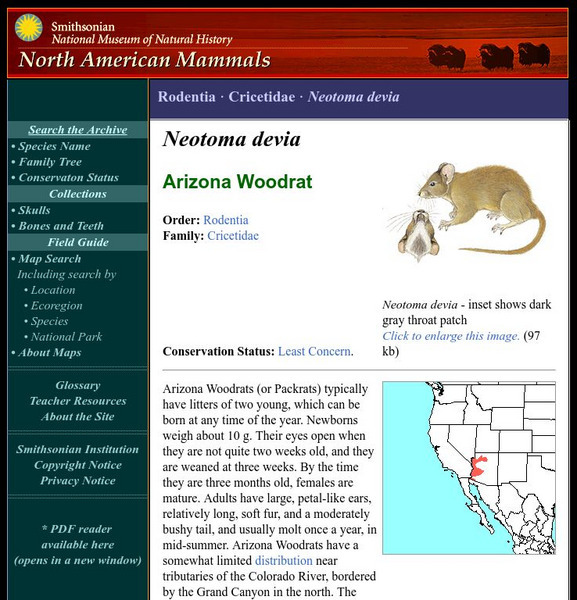Other
House Rabbit Society: Rabbit Care by Category Faq
Very helpful and easy to navigate site on rabbit care. Issues are broken down by topics including: diet, litter training, mental health, grooming, housing, and more. Very informative!
Alabama Learning Exchange
Alex: Team Up to Clean Up
In this lesson plan from "The Friends of Auntie Litter", (www.auntielitter.org), natural and human-made litter will be explored. Students will also participate in a litter removal activity. This lesson plan is one from the "Take Pride...
Alabama Learning Exchange
Alex: A Breath of Fresh Air
In this instructional activity from "The Friends of Auntie Litter", (www.auntielitter.org), air pollution will be explored. Auntie Litter and the Pollution Patrol learn how smog forms and find out how to keep the air clean and free of...
Other
North Carolina Department of Energy and Natural Resources: Pollution Solutions
Try to find at least eight things in the picture that could cause litter, waste, or other pollutants to end up in the storm drain and eventually flow into nearby lakes and streams. Includes a link to an interactive page of this activity....
Curated OER
Kids Health: A Guide to Eating for Sports
Television ads and magazines are littered with new sports drinks and supplements that claim to enhance performance for athletes. Are these claims proven to be true or just cunning marketing schemes? This article delves into the hype and...
Alabama Learning Exchange
Alex: Earth, We're in It Together!
In this lesson from "The Friends of Auntie Litter", (www.auntielitter.org), Earth Day will be explored. This lesson is one from the "Take Pride Statewide" series. *This lesson is provided by Lana Holmes.
Alabama Learning Exchange
Alex: Envision, Enhance, Enjoy
In this lesson from "The Friends of Auntie Litter", (www.auntielitter.org), Alabama's state parks will be explored. This lesson is one from the "Take Pride Statewide" series. *This lesson is provided by Julie Danley, Pam Walston, and Pat...
Alabama Learning Exchange
Alex: Earth: We're in It Together!
In this lesson from "The Friends of Auntie Litter", (www.auntielitter.org), conservation and describing ways to protect the Earth will be explored. Students will also create a mural of ways to protect our planet. This lesson is one from...
Environmental Education for Kids
Eek!: Community Action & Citizen Science: Adopt a Beach
Learn about a program in Wisconsin called Adopt-a-Beach. Schools, families, businesses and community groups adopt beaches and shoreline areas in their local community to conduct litter removal and monitoring and water quality testing.
Polk Brothers Foundation Center for Urban Education at DePaul University
De Paul University: Center for Urban Education: Making Progress [Pdf]
"Making Progress" is a one page, fictional, reading passage about students clearing the trash from a vacant lot near the school and planting a garden to beautify the neighborhood and show they care. It is followed by constructed-response...
Polk Brothers Foundation Center for Urban Education at DePaul University
De Paul University: Center for Urban Education: Making Progress [Pdf]
"Making Progress" is a one page, fictional, reading passage about students clearing the trash from a vacant lot near the school and planting a garden to beautify the neighborhood and show they care. It is followed by constructed-response...
Cornell Lab of Ornithology
Habitat Network: Brush Piles
Find out why brush piles are beneficial to a habitat.
Read Works
Read Works: A Clean Park
[Free Registration/Login Required] A literary text about a boy named Tyler who realized that he needed to pitch-in and help keep the park clean. A question sheet is available to help students build skills in reading comprehension.
Read Works
Read Works: Earth Helpers
[Free Registration/Login Required] An informational text about working together to make the Earth a better place. A question sheet is available to help students build skills in reading comprehension.
World Wildlife Fund for Nature
World Wildlife Fund: Wolf (Timber)
This resource provides basic information and photos of the Timber Wolf.
Curated OER
Residents Walk Through a Street Littered With Debris in Pangandaran
From July, 2006, photographic slideshow graphically detailing the tsunami that hit the Indonesian island of Java.
Smithsonian Institution
National Museum of Natural History: American Mammals: Alaskan Hare
Female Alaskan Hares nurse their young for an extended period, providing them with enough nutrition to grow extraordinarily quickly during the short Alaskan summer. There is an average of six furry little hares in a litter, and females...
Better Planet Productions
Earth Care: Good Garbage vs Bad Garbage [Pdf]
Kindergarten students will participate in schoolyard cleanup and learn to tell the difference between safe and unsafe litter.
Better Planet Productions
Earth Care: Sort and Sift [Pdf]
In this lesson, students will examine the litter they produce in their classroom and that their families produce at home, and identify ways they can reduce waste and recycle more.
Other
Earth Day Canada: Eco Kids: Use a Reusable Water Bottle
Did you know that used bottles and cans often end up in landfills or worse, in our lakes and oceans or on the ground as litter! This pollution hurts birds, turtles, and other wildlife. These are some of the reasons why we should use...
ClassFlow
Class Flow: Changes in Habitats
[Free Registration/Login Required] A 2nd grade unit on how people and weather can change habitats. Topics include too much and too litter rain (flooding and drought), lightning and fire, and land, water, and air pollution. This flipchart...
Smithsonian Institution
National Museum of Natural History: American Mammals: Arizona Woodrat
Arizona Woodrats (or Packrats) typically have litters of two young, which can be born at any time of the year. Newborns weigh about 10 g. Learn more about the Neotoma devia, more commonly known as an Arizona Woodrat, in this easy-to-read...
Smithsonian Institution
National Museum of Natural History: American Mammals: Southern Short Tailed Shrew
The Southern Short-tailed Shrew is a highly active, primarily nocturnal predator. It is most common in moist, well-drained hardwood forests or pine stands, especially where deep organic litter provides easy burrowing for shelter and...
Smithsonian Institution
National Museum of Natural History: American Mammals: Pinyon Deermouse
Pinyon Deermice reproduce from mid-February through mid-November, giving birth to litters of 3-6 blind, hairless young that weigh about 2.3 g each. Learn more about the Peromyscus truei, more commonly known as a Pinyon Mouse, in this...
Other popular searches
- Litter Bug
- Pick of the Litter
- Litter in the Environment
- Ocean Litter
- Litter Critters
- Litter Survey
- Beach Litter
- Litter Management
- Litter Science
- Litter Minimization
- Photo Essay on Littering
- Identifying Litter



















